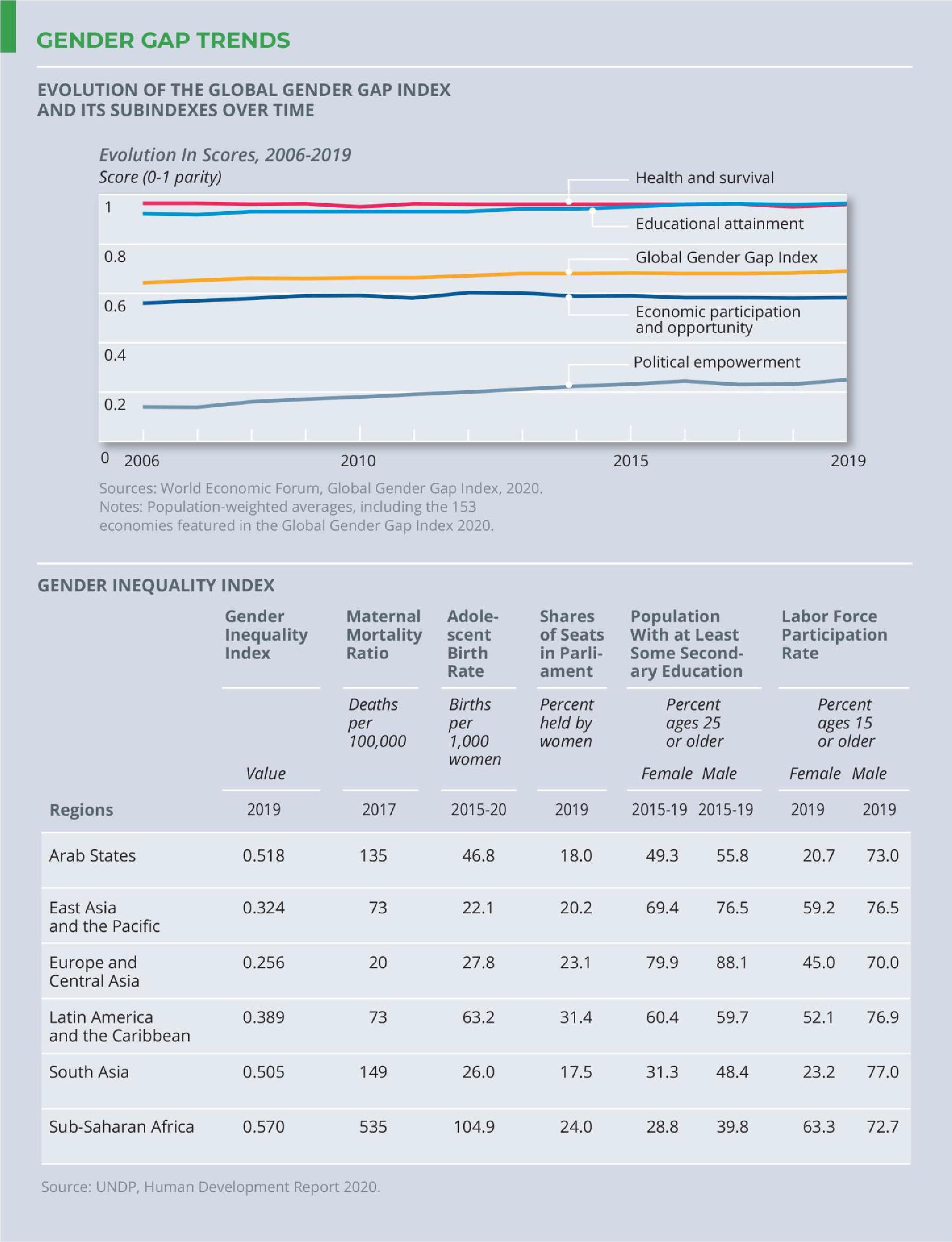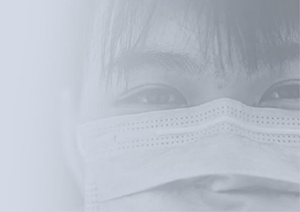DEEPER LOOKS
The Future of Women’s Rights 
This paper was produced by the National Intelligence Council’s Strategic Futures Group in consultation with outside experts and Intelligence Community analysts to help inform the integrated Global Trends product, which published in March 2021. However, the analysis does not reflect official US Government policy, the breadth of intelligence sources, or the full range of perspectives within the US Intelligence Community.
After decades of improvements in women’s formal education, economic participation, and political leadership, progress in many countries has slowed in recent years, due to the slowing progress in some regions against higher-level human development goals, strongly held views of women’s roles in a number of countries, and the economic effects of the COVID-19 pandemic. Moreover, deep-seated patriarchal attitudes are likely to remain a hindrance to gender equality in some regions during the next two decades. Some polling and research indicates that these attitudes may change over generational periods, with the potential for more rapid change due to societal disruption, such as wars and perhaps the pandemic. Expanding Internet access and e-commerce platforms over time could also enable more women in more places to push for greater equality, as well as improve their prospects for employment and higher levels of education, but also might facilitate repression by authoritarian regimes.
DECADES OF PROGRESS…
For many decades, the world has seen large increases in gender equality, and in most countries, the legal barriers to women’s educational, economic, social, and political participation are gone. Worldwide, women are more educated today than at any point in history, and gender gaps between women’s and men’s academic attainments are rare in countries with high levels of educational achievement. In fact, women in some 50 countries on average have achieved a higher level of education than men have, and in others, they live longer and are healthier.
Female labor force participation rose markedly in the 20th century, and in a majority of countries at all income levels women’s participation in paid labor is higher today than it was in 1990. Since the end of World War II, 64 countries on every continent have had at least one elected or appointed female head of state. Eighty-five percent of them took office after 1990. Latin America and the Caribbean are notable with 12 of the region’s 33 countries having had female heads of state (including presidents and prime ministers), with women currently leading Aruba, Barbados, St. Maarten, and Trinidad and Tobago.
Growing Say in Foreign Policy. An increasing number of countries are incorporating advancement of gender equality into their foreign policy establishment and agendas. As of March, 32 countries had female foreign ministers, 25 had female ministers of defense, and several had ambassador-level positions with the explicit aim of promoting women’s rights. Sweden and Mexico have instituted explicitly “feminist” foreign policies—which prioritize devoting resources to improving women’s rights as well as ensuring representation in foreign and security institutions—with possibly more countries following suit in the near future.
Exercising Greater Choice. As women have gained opportunities, they are seeking roles in society beyond those traditionally afforded them. In Japan, women are consciously postponing or foregoing marriage, partly reflecting their dissatisfaction with enduring societal expectations that women will continue to perform the bulk of unpaid domestic chores even when they work outside the home. Moreover, labor force participation rates for women in Japan have increased during the past several decades. Similarly, Brazilian women have significantly increased their participation in the workforce since 1990, and they are prioritizing careers and other forms of personal goals over large families,
in part because of higher rates of education for women and greater urbanization.
Increasing Public Advocacy. Women have also used their greater political voice to shed new light on harassment, discrimination, and violence through social movements, such as #MeToo, India’s #IWillGoOut for the unhindered right to go out in public, and Latin America’s #NiUnaMenos, spotlighting violence against women, and through myriad marches, protests, and on-line campaigns. In early 2020, millions of Mexican women went on a national strike to protest gender violence—a move enabled by sympathetic employers and universities.
International Recognition of Women’s Issues. During the past 25 years, countries have come together at the UN to pass several landmark agreements that protect and empower women, including the Beijing Platform for Action in 1995 with the goal of achieving legal gender equality, UN Security Council resolution 1325 on “Women and Peace and Security” affirming women’s vital role in resolving conflicts and maintaining peace, and the UN Millennium Development Goals in 2000, which included “gender equality and empowerment of women and girls” as one of its tenets.
Agricultural Practices. Global water demand for agriculture—the single largest consumer of water—is projected to increase by 19 percent from current levels by 2050. By 2040, about 40 percent of all irrigated agriculture is expected to face extremely high water stress.

(Graphic 1: GENDER GAP TRENDS - Click image to enlarge)
…SLOWING IN SOME AREAS
Despite these initiatives and advances, progress toward gender equality is slowing in some areas. To some extent, this reflects the slowing gains in overall human development; for example, basic levels of education have largely been met but expanding access to secondary education is a more difficult challenge. The COVID-19 pandemic has illustrated how quickly progress can be reversed for women, particularly because women have been more likely to stay at home to care for children. Although women are the primary producers of food in many countries, they have limited or no rights to land ownership in some parts of the world. Even where laws allow women to own land, such as in Kenya, no titles have been passed to women.
Physical Abuse Levels Remain High. Across all societies, women continue to face physical risk and dangers at home and work. Sexual violence—including at the hands of family members or domestic partners—remains a global scourge. A WHO study in 2020 estimates that more than one in four women have experienced physical or sexual violence form an intimate partner in their lifetime. The UN estimated in 2018 that globally, 137 women per day are killed by a partner or family member. Russia and Hungary, for example, have reduced protections for women, including decriminalizing domestic and sexual violence. Multiple studies also show that violence against women reduces economic productivity, reducing global output by as much as 4 percent, by one estimate. A number of recent studies indicate that globalization and expanding access to the Internet and social media have increased the sexual exploitation of girls and women.
Continued Discrimination in the Workplace. World Economic Forum data indicate that the global gender gap in both paid labor participation and wage equality has actually widened since 2017. A survey completed between 2013-2018 of 2,300 publically listed companies in 14 well-established industries across a range of sectors, including energy, materials, industrials, consumer products, utilities, and waste services, indicated that women hold only 13 percent of board seats. Globally, women are more women are more likely than men are to work in the precarious and ill-paid informal sector, far less likely to start their own businesses, and are underrepresented in STEM fields. One study in 2019 indicates that by 2030, an estimated 40-160 million women may need to transition into higher skilled roles; by comparison, 60-275 million men may need to transition.
Hurdles to Political Participation. Even with a dramatic rise in female legislators since the 1990s, the proportion worldwide is only about 25 percent. In some countries, women who seek or attain political office have to deal with threatened or actual violence, including murder, often deterring other women from striving for public office. Subordination of women to men regardless of educational level is enshrined in family law in many parts of Sub-Saharan Africa, the Middle East, and South Asia.
THE LONG ROAD AHEAD
Deep-seated patriarchal attitudes worldwide, as well as some economic and demographic trends, are likely to remain a hindrance to gender equality during the next two decades. Although a Pew survey from 2018 indicates that attitudes are shifting—in a majority of countries surveyed, younger people are more likely to favor gender egalitarianism—which suggests that these attitudes may change over generational periods, about 50 percent of respondents to a UNDP survey in 2020 claimed that men make better political leaders and business executives.
Similarly, a Pew survey in 2020 across 34 countries representing views from each global region on gender equality reported that 40 percent of respondents stated that men should have preferential treatment when jobs are scarce, despite the vast majority of respondents stating it was important for women in their countries to have the same rights as men.
IMPACT OF COVID-19 PANDEMIC ON WOMEN'S INCOMES, EDUCATION, AND HEALTH
 The global economic disruptions caused by the COVID-19 pandemic had a greater effect on women because they tend to work in economic sectors hit hard by the pandemic, such as the hospitality industry and other service work. According to a poll conducted in late-2020 in 13 Latin American and Caribbean countries, female workers in the region were 44 percent more likely than men to lose their jobs at the onset of the pandemic. In 2020, women in Europe experienced a total wage bill loss of about 8.1 percent compared with just 5.4 percent for men. In addition, stay-at-home measures designed to stem the spread of COVID-19 combined with social expectations have frequently compelled women to give up paid work or put their educations on hold to care for their families and have put them at greater risk of domestic violence.
The global economic disruptions caused by the COVID-19 pandemic had a greater effect on women because they tend to work in economic sectors hit hard by the pandemic, such as the hospitality industry and other service work. According to a poll conducted in late-2020 in 13 Latin American and Caribbean countries, female workers in the region were 44 percent more likely than men to lose their jobs at the onset of the pandemic. In 2020, women in Europe experienced a total wage bill loss of about 8.1 percent compared with just 5.4 percent for men. In addition, stay-at-home measures designed to stem the spread of COVID-19 combined with social expectations have frequently compelled women to give up paid work or put their educations on hold to care for their families and have put them at greater risk of domestic violence.
The Organization for Economic Cooperation and Development, the World Bank, and the IMF project a robust global growth rate this year, albeit acknowledging considerable uncertainty regarding the global trajectory of the COVID-19 pandemic during the next few years, but there are likely to be large regional variations that will affect women's ability to reenter the workforce in some countries. Developed economies probably are going to recover faster, while emerging markets and developing countries are unlikely to rebound to pre-COVID-19 GDP growth levels until after 2022, according to these projections. Studies of pre-COVID-19 recessions suggest that women have more difficulty than men regaining employment and recouping lost wages during a recovery.
The diversion of medical resources to deal with the outbreak probably has diminished women's access to health and reproductive services. In India, for example, medical services for women had to be re purposed to support COVID-19 efforts.
Role of Societal Structures and Traditions. Patriarchal family structures that remain the norm in several parts of the world often perpetuate gender inequality. Child brides—particularly prevalent in parts of Sub-Saharan Africa and South Asia—are particularly powerless, cut off at an early age from educational and economic opportunities, and at high risk for both domestic violence and maternal injury and death. Many societies’ acceptance or rejection of gender equality could hinge on whether they see it as an alien or Western value. Any values discussion may be further complicated by continued large migration flows across national borders, which will bring groups with widely varying views on gender equality into close proximity.
The ultimate in devaluation of women and girls in a society—denial of their right to live—is manifested by “femicide,” “dowry deaths,” “honor killings,” and other assorted murders of females worldwide. The number of nations with skewed sex ratios as the result of the abortion of female fetuses and killings of newborn baby girls quadrupled between 1990 and 2016. Sex-selected abortion is most prevalent in China and India, although it is also common in the South Caucasus, Southeast Europe, and other countries with a preference for sons.
Impact of Economic and Demographic Trends. Pandemic-related economic problems will place fiscal constraints on many countries that will reduce public outlays for health, education, and infrastructure that women in many countries rely on. Developed countries may also react to the pandemic’s disruption to supply chains by on-shoring or automating manufacturing, adding to strains on developing countries where women’s rights face the greatest challenges. The growing burden of caring for increasingly aging populations, especially in Europe and East Asia, is also likely to fall disproportionately on women who provide most of the care in many societies.
WHAT COULD CREATE A DIFFERENT TRAJECTORY?
The Promise of Technology. Technological advances during the next two decades could provide opportunities for more women to improve their prospects for employment, attain higher levels of education, and advocate for their rights, if accompanied by a supportive societal and cultural environment. Social media platforms have been essential for connecting women with common concerns, promoting movements such as #MeToo and India’s #IWillGoOut movement, and organizing massive demonstrations. As Internet access expands globally, more women and girls could have better educational opportunities and access to information. In addition, a growing number of e-commerce sites are providing a means for women entrepreneurs to gain access to financing and global markets. The UN, for example, is sponsoring an e-Trade for Women initiative that seeks to develop women digital entrepreneurs in developing countries.
A Pandemic Silver Lining? The COVID-19 pandemic may have the potential to catalyze societal shifts in attitudes toward gender equality during the next two decades. Some equality breakthroughs in the 20th century were catalyzed by global and regional cataclysms that reordered societies. For example, many Western women gained the vote as the result of the geopolitical and societal upheavals of World War I, and women entered the workforce in large numbers during World War II. Historians have also cited Rwandan women’s progress following the 1994 genocide, which forced dramatic shifts in women’s roles in that country, including gender parity in its legislature and the right of women to own land and work in paid employment.
In the COVID-19 era, it became apparent that a large number of jobs viewed as “essential”—from medical professionals to grocery store employees—are performed by women in frequently perilous conditions. As a result, women—including those in traditionally low-status care work—could gain a new platform for demanding a greater voice, respect, and financial reward.
GENDER EQUALITY IMPLICATIONS FOR ECONOMICS, GOVERNANCE, AND CONFLICT
 Gender equality has global strategic implications with a body of scholarship demonstrating that treatment of women in a society is a leading indicator of that society's ability to develop, democratize, and exist peacefully with its neighbors. This is an area of ongoing research and debate. The most empirical evidence is in the area of economics.
Gender equality has global strategic implications with a body of scholarship demonstrating that treatment of women in a society is a leading indicator of that society's ability to develop, democratize, and exist peacefully with its neighbors. This is an area of ongoing research and debate. The most empirical evidence is in the area of economics.
- Economic Prosperity: There are long-recognized links between increases in female autonomy (e.g. freedom to delay marriage and to work outside the home) and economic prosperity going back centuries. The economic growth of China and South Korea was preceded by a rise in female autonomy in the 1960s and 1970s, whereas gender inequality has been associated with lower GDP growth in other developing countries during the last few decades. Prosperity in more equal societies is due in part to women's investing more of their earnings in their families and communities than men typically invest. In addition, international financial institutions and investors have found an inverse correlation between return on investment and high levels of gender-based violence and discrimination in a society.
- Democratic Governance: A body of scholarship indicates that patriarchal families that allow women little say over the number of children they produce consistently undermine the ability of a society to form lasting democracies. For example, patriarchal values such as conformity, deference to hierarchy, self-censorship, and suspicion of outsiders are much more amenable to authoritarian forms of governance. In addition, societies with high population growth- and by extension more youthful populations- are statistically more prone to failed democratization attempts than societies with a higher median age.
- Instability and Conflict: Societies where violence against women is entrenched are more prone to instability and conflict. Habitual violence in the home conditions those who witness it, such as children, to see violence as the means for dealing with differences, whether ethnic, religious, cultural, racial, or ideological.


